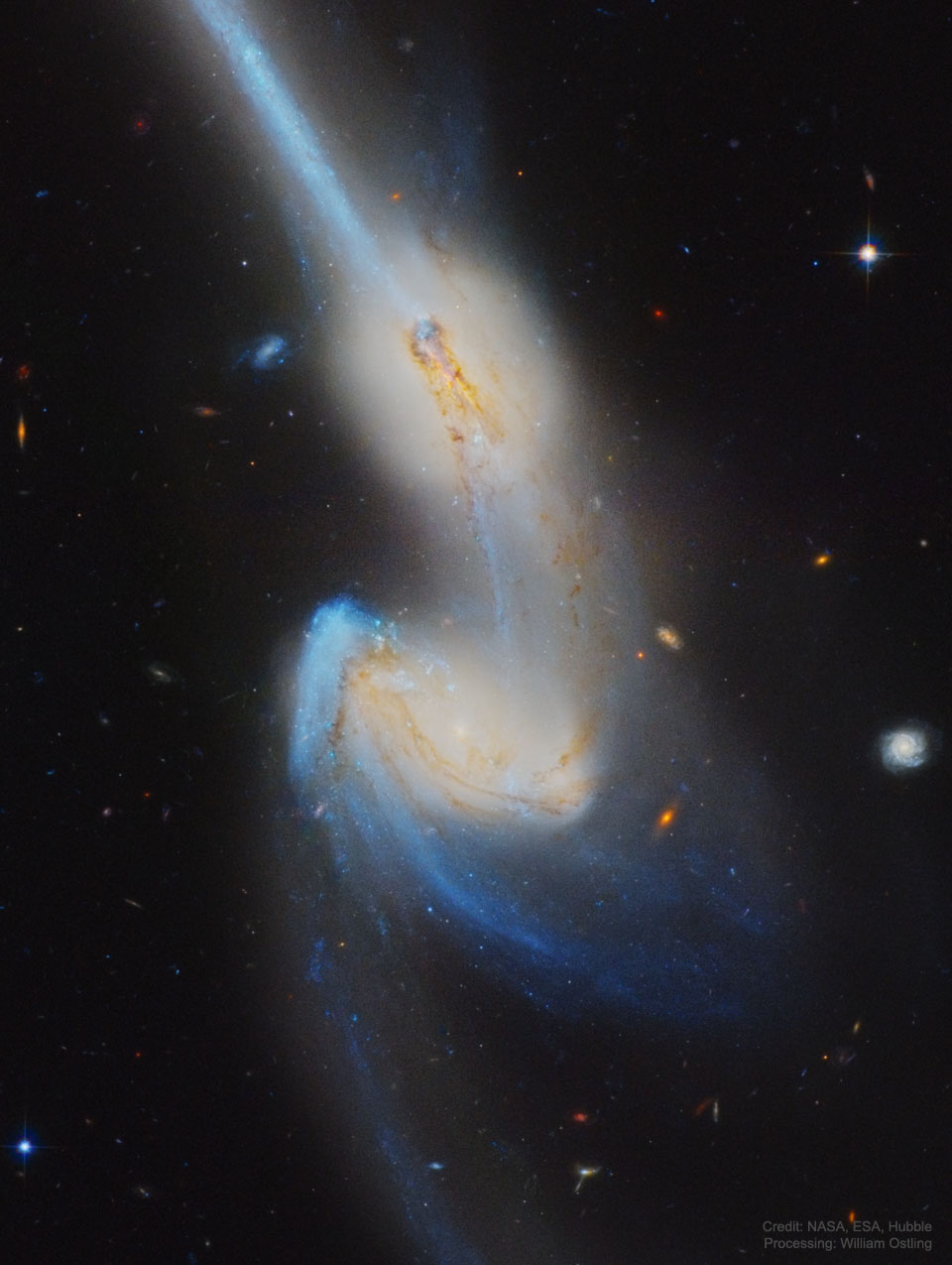04. October 2021
NGC 4676:雙鼠星系相碰 ê 時陣

探索宇宙1!逐工會揀一幅無仝款 ê 影像抑是相片,𤆬你熟似咱這个迷人 ê 宇宙,閣有專業天文學者2為你3解說4。
- 原始文章:NGC 4676: When Mice Collide
- 影像來源:NASA, ESA, Hubble; 資料處理 kah 版權: William Ostling (The Astronomy Enthusiast)
- APOD 英語版嘛有:面冊, Instagram, kah Twitter
- 台文翻譯:An-Li Tsai (NCU)
[漢羅] NGC 4676:雙鼠星系相碰 ê 時陣
這兩个巨型 ê 星系互相 kā 對方搝開。 Kā 叫做「雙鼠星系」是因為 in 攏有長長 ê 尾溜。 是講兩个 捲螺仔星系 敢若已經互相迵過矣。 會產生兩條 長長 ê 尾溜,是因為兩个攏 tī 星系 較近 kah 較遠 ê 部份 產生 ê 引力差。 因為這个距離傷遠,宇宙交互作用 to̍h 敢若是慢動作,超過幾若億萬年。 NGC 4676 tī Bernice ê 頭鬃 ê 星座 (后鬃座) ê 方向揣會著,離咱有 3 億 光年 遠,可能是 彗鬚星系團 ê 成員之一。 這張相片 是 tī 2002 年用 哈伯太空望遠鏡 先進巡天 kha-mé-lah 翕 ê。 這兩隻 星系鳥鼠 可能會 tī 紲落來 ê 十億年內底,一擺閣一擺相挵,按呢 to̍h 袂繼續互相搝開。 落尾,兩个星系會 黏 做一个。
[POJ] NGC 4676: Siang-chhí seng-hē siōng-pōng ê sî-chūn
Chit nn̄g-ê kū-hêng ê seng-hē hō͘-siong kā tùi-hong giú-khui. Kā kiò-chò "Siang-chhí seng-hē" sī in-ūi in lóng ū tn̂g-tn̂g-ê bóe-liu. Sī kóng nn̄g-ê kńg-lê-á seng-hē ká-ná í-keng hō͘-siong thàng--kòe ah. Ē sán-seng nn̄g-tiâu tn̂g-tn̂g ê bóe-liu, sī in-ūi nn̄g-ê lóng tī seng-hē khah-kīn kah khah-hn̄g ê pō͘-hūn sán-seng ê ín-le̍k-chha. In-ūi chi̍t-ê kū-lî siūⁿ-hn̄g, ú-tiū kāu-hō͘-chok-iōng to̍h ká-ná sī bān tōng-chok, chhiau-kòe kúi-nā-ek-bān nî. NGC sù-lio̍k-chhit-lio̍k tī Bernice ê thâu-chang ê seng-chō (Hiō-changj-chō) ê hong-hiòng chhōe-ē-tio̍h, lî lán ū saⁿ-ek kng-nî hn̄g, khó-lêng sī Hūi-chhiu seng-hē-thoân ê sêng-goân chi-it. Chit-tiuⁿ siōng-pōng sī tī jī-khòng-khòng-jī nî iōng Ha-peh-thài-khong-bōng-oán-kiàⁿ Sian-chìn-sûn-thian kha-mé-lah hip ê. Chit nn̄g-chiah seng-hē-niáu-chhí khó-lêng ē tī sòa-lo̍h-lâi ê cha̍p-ek nî lāi-té, chit-pái koh chit-pái sio-lòng, án-ni to̍h bōe kè-sio̍k hō͘-siong giú-khui. Lo̍h-bóe, nn̄g-ê seng-hē ē liâm-chō chi̍t-ê.
[KIP] NGC 4676: Siang-tshí sing-hē siōng-pōng ê sî-tsūn
Tsit nn̄g-ê kū-hîng ê sing-hē hōo-siong kā tuì-hong giú-khui. Kā kiò-tsò "Siang-tshí sing-hē" sī in-uī in lóng ū tn̂g-tn̂g-ê bué-liu. Sī kóng nn̄g-ê kńg-lê-á sing-hē ká-ná í-king hōo-siong thàng--kuè ah. Ē sán-sing nn̄g-tiâu tn̂g-tn̂g ê bué-liu, sī in-uī nn̄g-ê lóng tī sing-hē khah-kīn kah khah-hn̄g ê pōo-hūn sán-sing ê ín-li̍k-tsha. In-uī tsi̍t-ê kū-lî siūnn-hn̄g, ú-tiū kāu-hōo-tsok-iōng to̍h ká-ná sī bān tōng-tsok, tshiau-kuè kuí-nā-ik-bān nî. NGC sù-lio̍k-tshit-lio̍k tī Bernice ê thâu-tsang ê sing-tsō (Hiō-changj-tsō) ê hong-hiòng tshuē-ē-tio̍h, lî lán ū sann-ik kng-nî hn̄g, khó-lîng sī Huī-tshiu sing-hē-thuân ê sîng-guân tsi-it. Tsit-tiunn siōng-pōng sī tī jī-khòng-khòng-jī nî iōng Ha-peh-thài-khong-bōng-uán-kiànn Sian-tsìn-sûn-thian kha-mé-lah hip ê. Tsit nn̄g-tsiah sing-hē-niáu-tshí khó-lîng ē tī suà-lo̍h-lâi ê tsa̍p-ik nî lāi-té, tsit-pái koh tsit-pái sio-lòng, án-ni to̍h buē kè-sio̍k hōo-siong giú-khui. Lo̍h-bué, nn̄g-ê sing-hē ē liâm-tsō tsi̍t-ê.
[English] NGC 4676: When Mice Collide
These two mighty galaxies are pulling each other apart. Known as the "Mice" because they have such long tails, each spiral galaxy has likely already passed through the other. The long tails are created by the relative difference between gravitational pulls on the near and far parts of each galaxy. Because the distances are so large, the cosmic interaction takes place in slow motion -- over hundreds of millions of years. NGC 4676 lies about 300 million light-years away toward the constellation of Bernice's Hair (Coma Berenices) and are likely members of the Coma Cluster of Galaxies. The featured picture was taken with the Hubble Space Telescope's Advanced Camera for Surveys in 2002. These galactic mice will probably collide again and again over the next billion years so that, instead of continuing to pull each other apart, they coalesce to form a single galaxy.
詞彙學習
| 漢羅 | POJ | KIP | 華語 | English |
|---|---|---|---|---|
| 雙鼠星雲 | Siang-chhí seng-hē | Siang-tshí sing-hē | 雙鼠星系 | Mice galaxy |
| 捲螺仔星系 | kńg-lê-á seng-hē | kńg-lê-á sing-hē | 螺旋星系 | spiral galaxy |
| 后鬃座 | Hiō-chang-chō | Hiō-tsang-tsō | 后髮座 | Coma Berenices |
| 彗鬚星系團 | Hūi-chhiu seng-hē-thoân | Huī-tshiu sing-hē-thuân | 彗髮星系團 | Coma Cluster of Galaxies |
| 先進巡天 kha-mé-lah | Sian-chìn-sûn-thian kha-mé-lah | Sian-tsìn-sûn-thian kha-mé-lah | 先進巡天照相機 | Advanced Camera for Surveys |
| 哈伯太空望遠鏡 | Ha-peh-thài-khong-bōng-oán-kiàⁿ | Ha-peh-thài-khong-bōng-uán-kiànn | 哈伯太空望遠鏡 | Hubble Space Telescope |